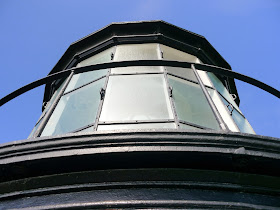We visited the Wright Brothers National Memorial in early October 2015. After touring the visitor center, we went outside to the open field where the first controlled, powered flight took place. In 1903, the field and dunes were sand, but grass and other vegetation has been planted over the years to stabilize the area for future generations. While a major highway skirts the edge of the memorial today, in the early 1900s it was several miles from the site to the nearest house and road across the dunes. Wilber, Orville and a small group of local men set up camp on the dunes and tested gliders by carrying them up the slopes of Kill Devil Hill dune and gliding down to the relatively flat sandy area to the north of the dune.
The first four powered flights were all conducted on December 17, 1903. A wind gust flipped the Flyer after the fourth flight, destroying the engine and damaging the Wright Flyer I.
A sixty foot high memorial atop the 90 foot high Kill Devil Hill was dedicated in 1932. Around its base is this inscription:
In commemoration of the conquest of the air by the brothers Wilbur and Orville Wright conceived by genius achieved by dauntless resolution and unconquerable faith.
 |
| Replica workshop and hangar |
 |
| Historical marker below Kill Devil Hill |
 |
| Twenty-fifth anniversary plaque at the takeoff location |
 |
| Flight distance markers |
 |
| Looking back from the end of the fourth flight |
 |
| Wright Brothers Monument |
 |
| Looking south from Kill Devil Hill |
 |
| Looking east to the Atlantic Ocean |
 |
| Hangar, workshop and visitor center from atop Kill Devil Hill |
 |
| First Flight Centennial sculpture from atop Kill Devil Hill |
 |
| Centennial sculpture from the parking area |
 |
| Wilbur at the controls |
 |
| Orville helped balance the plane on the rail |
 |
| The sculpture recreates the historic photograph taken by John T Daniels |
 |
| Another view of Orville |
 |
| A closer view of Wilbu |
An entry fee of $7 per person is good for seven consecutive days. Other fee payment options include the America the Beautiful - National Parks and Federal Recreational Lands passes including the Annual Pass ($80), Senior Pass ($10 for lifetime), Access Pass (free with documented disability) and Military Annual Pass (free for active duty personnel).
The Memorial website is
http://www.nps.gov/wrbr/index.htm.


























































